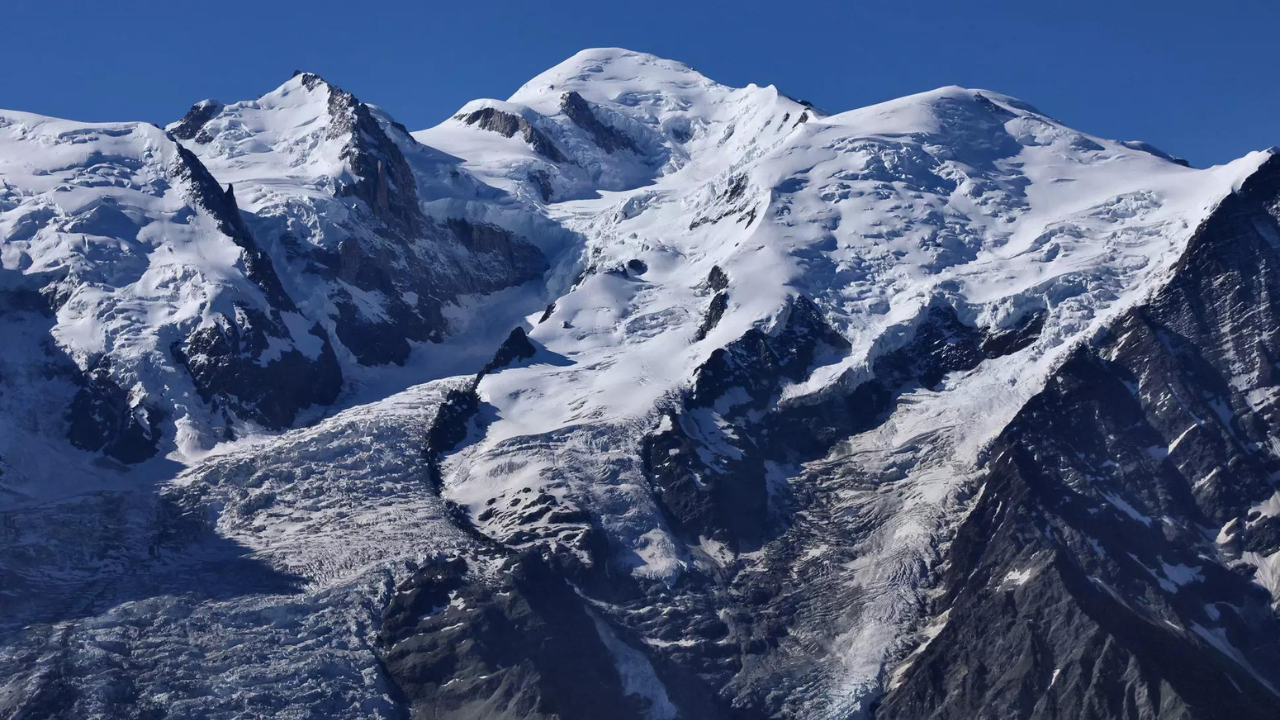Researchers have revealed that Mont Blanc, Western Europe’s highest peak, has experienced a loss of over two meters (6.5 feet) in just two years, marking its lowest level since accurate measurements began 22 years ago. This reduction in height is attributed to warmer summers that have caused a decrease in snowpack size.
A team of topographers, who conduct measurements every two years, announced this finding during a news conference held in Chamonix in the French Alps on Thursday. According to their measurements, the mountain’s current height is 4,805.59 meters (15,766 feet), which is 2.22 meters lower than the measurement taken in September 2021, which was 4,807.81 meters (15,773 feet).
The peak of Mont Blanc reached its highest recorded summit in 2007, measuring 4,810.90 meters.
European glaciers, located at lower altitudes compared to glaciers in other regions, are highly susceptible to global warming. Scientific data shows that these glaciers lost approximately one-third of their volume between 2000 and 2020. Glaciologists estimate that in 2022 alone, up to seven percent of the remaining glacier mass might have disappeared.
Cecile Taffin of the UNGE surveyors union explained that the top of Mont Blanc is subject to movement and has experienced height variations of over two meters in the past. She suggested that this year’s particularly low level is likely due to a lack of rain and a hot summer.
Precise GNSS satellite measurements of Mont Blanc began in September 2001 when its height was recorded as 4,010.40 meters. Between 2001 and 2013, the mountain’s height ranged between 4,808 and 4,810 meters, reaching a record of 4,810.90 meters in 2007. However, since 2013, it has been consistently decreasing in height.
The total height of Mont Blanc depends on its snowpack, which typically increases during the summer months as rain on the peak turns into snow. Farouk Kadded at Leica Geosystems noted that this year, for the first time since 2015 when measurements were taken in June as well, Mont Blanc’s snowpack remained virtually unchanged between June and September. Typically, Mont Blanc gains approximately one meter in height during this period, but this did not occur due to several days of positive temperatures, including a record high of 10 degrees Celsius.
“It is hard to believe we are going to recuperate a few meters over the next two years. There is a lot of variation, but there is a slight downward trend,” Kadded said.
“It’s now up to the climatologists, glaciologists and other scientists to make use of all the data we’ve collected and come up with theories to explain” the shrinkage, said Jean des Garets, chief geometer in the Haute-Savoie department of southeastern France.
(With inputs from agencies)
A team of topographers, who conduct measurements every two years, announced this finding during a news conference held in Chamonix in the French Alps on Thursday. According to their measurements, the mountain’s current height is 4,805.59 meters (15,766 feet), which is 2.22 meters lower than the measurement taken in September 2021, which was 4,807.81 meters (15,773 feet).
The peak of Mont Blanc reached its highest recorded summit in 2007, measuring 4,810.90 meters.
European glaciers, located at lower altitudes compared to glaciers in other regions, are highly susceptible to global warming. Scientific data shows that these glaciers lost approximately one-third of their volume between 2000 and 2020. Glaciologists estimate that in 2022 alone, up to seven percent of the remaining glacier mass might have disappeared.
Cecile Taffin of the UNGE surveyors union explained that the top of Mont Blanc is subject to movement and has experienced height variations of over two meters in the past. She suggested that this year’s particularly low level is likely due to a lack of rain and a hot summer.
Precise GNSS satellite measurements of Mont Blanc began in September 2001 when its height was recorded as 4,010.40 meters. Between 2001 and 2013, the mountain’s height ranged between 4,808 and 4,810 meters, reaching a record of 4,810.90 meters in 2007. However, since 2013, it has been consistently decreasing in height.
The total height of Mont Blanc depends on its snowpack, which typically increases during the summer months as rain on the peak turns into snow. Farouk Kadded at Leica Geosystems noted that this year, for the first time since 2015 when measurements were taken in June as well, Mont Blanc’s snowpack remained virtually unchanged between June and September. Typically, Mont Blanc gains approximately one meter in height during this period, but this did not occur due to several days of positive temperatures, including a record high of 10 degrees Celsius.
“It is hard to believe we are going to recuperate a few meters over the next two years. There is a lot of variation, but there is a slight downward trend,” Kadded said.
“It’s now up to the climatologists, glaciologists and other scientists to make use of all the data we’ve collected and come up with theories to explain” the shrinkage, said Jean des Garets, chief geometer in the Haute-Savoie department of southeastern France.
(With inputs from agencies)

